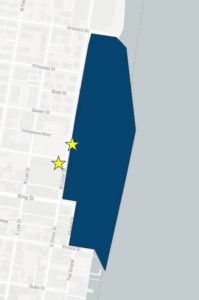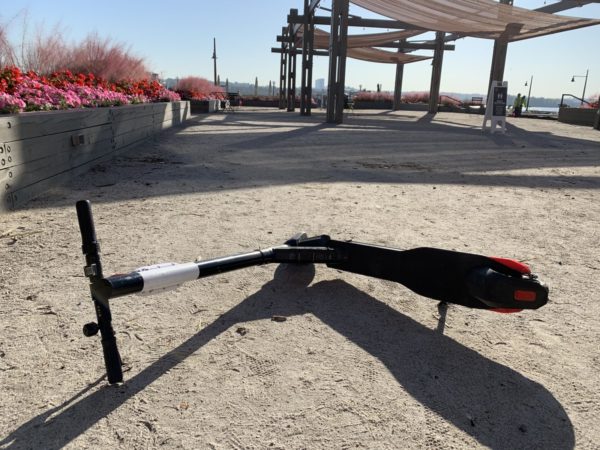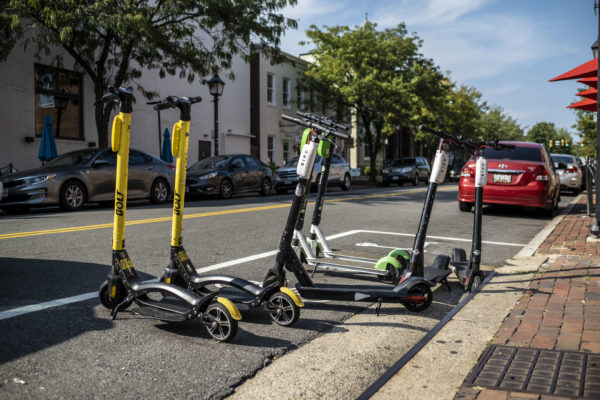While geofencing for scooters generally means blocking them from scooting through an area, new geofencing measures in Alexandria are aimed at keeping scooters parking in certain places.
New scooter regulations have blocked scooters from parking in a multi-block stretch east of N. Union Street, between Oronoco Street and Prince Street. The result has been an 80 percent decrease in scooter parking on the waterfront, staff told the Waterfront Commission at its meeting last week.
When users try to end their ride in the restricted area, a message will appear on their phone telling them to move the scooter elsewhere.
 Before geofencing, staff said there were approximately 1,500 scooters parked on the waterfront every month. In September, that fell to around 250.
Before geofencing, staff said there were approximately 1,500 scooters parked on the waterfront every month. In September, that fell to around 250.
The city also tried to incentivize legal scooter parking by adding two parking corrals to the area, which have had roughly 400 scooters parked there per month.
This hasn’t stopped scooters from riding through the areas, despite signs encouraging visitors not to do so, but there has been a 50-65 percent decline in scooters riding through the waterfront, staff said.
Geofencing isn’t a fix-all solution. Staff noted that the geofencing can only cover large areas, with accuracy up to only about 20-30 feet. Despite the decline, neglected scooters littering the waterfront are still a common sight.
“It’s bad behavior and it’s going to continue,” said Mark Michael Ludlow, a member of the Waterfront Commission.
The scooter corrals have also become something of a victim of their own success. Staff noted that corrals have frequently been overflowing and scooters have been left on nearby sidewalks.
Staff is currently collecting feedback from the city’s boards and commissions, with Phase II of the scooter program going to City Council for approval next month, for implementation in January.
Map via City of Alexandria
When Alexandria officials said they hope to see birds return to the Four Mile Run wetlands, they weren’t referring to Bird scooters — but yet, there was at least one there, in the water.
Concerns about scooters on sidewalks have dominated the local debate about the personal mobility devices, but the issue of abandoned scooters is nonetheless something with which Alexandria policymakers will have to grapple.
Thank you Vernon for the precise directions, @BirdRide retrieved their device. One less Bird in the water… pic.twitter.com/H38nuqBohF
— Zack Scooter (@mrpresident1776) October 10, 2019
City staff told ALXnow that the role Alexandria plays in the recovery of the scooters is relatively minimal. If scooters are found illegally parked, staff said those who find it should report the scooter to the respective scooter company. If illegally parked scooters are reported to the city, those reports are passed on to their respective company.
Streamlining the reporting process for abandoned scooters is part of the second phase of the scooter pilot program, currently being considered for implementation early next year.
“It’s on companies to retrieve the scooters, not the city,” staff said. “If the companies don’t retrieve the scooters, part of the second pilot program could include pulling that company’s permit, but so far they’ve been cooperative with us.”
Seven companies have been authorized to operate scooters and e-bikes in Alexandria. According to the mobility program’s website, the best way to identify and reporter the scooters is:
- Lime — green and yellow scooters. Can be reported at [email protected] or 888-546-3345
- Lyft — black and purple scooters. Can be reported online
- Jump — red and white scooters and bikes. Can be reported online at 844-505-9155 for scooters or 833-300-6106 for bikes.
- Bird — black and white scooters. Can be reported at [email protected] or 866-205-2442
- Bolt — yellow and black scooters. Can be reported at [email protected] or 866-265-8143
- Skip — blue and yellow scooters. Can be reported at [email protected] or 844-929-2687
- Spin — orange and white scooters. Can be reported at [email protected] or 888-262-5189
Over 200,000 trips have been made on e-scooters in Alexandria this year, but a sticking point with local officials is equitable access to scooters throughout the city.
Now the City Council is considering pushing scooter companies to ensure more scooters are available in parts of Alexandria outside of Old Town and Del Ray.
At an update on Alexandria’s dockless mobility pilot program — a fancy name for electric scooters — at Wednesday night’s City Council meeting, city officials noted the concentration of scooters in just a couple of areas.
“It seems more like we’re following a company’s model than focusing on equity across our community,” said Councilman John Chapman. “Our focus, for folks here on the Council, is to make sure all of our residents have the same opportunity. That’s not happening for docked and dockless mobility.”
With scooters becoming an increasingly prevalent transit option throughout the region, Chapman and Council Members Mohamed “Mo” Seifeldein, Canek Aguirre, and Redella “Del” Pepper pushed for requirements that scooter companies improve the equitability of access.
“If there’s a way to hold the companies accountable so that they are making sure to place scooters in different parts of the city, whether that’s by the Berg, Arlandria, the West End or the Beauregard corridor, I want to see that happen,” said Aguirre. “There’s no reason 99 percent of them should be in Del Ray and Old Town. It should be in other places because people have mobility needs across the entire city, not just in certain places. We, as a city, are looking to build out infrastructure to help that.”
There was recognition on the Council from Chapman that the business model incentivizes companies to concentrate most of their scooters in the busiest parts of town.
“I know that goes in the face of many of the business models for these companies, but as we experiment we need to focus on what the theme of our government is, which is equal access,” Chapman said. “I want to see us make a pretty significant change in what we’re willing to accept from these companies.”




